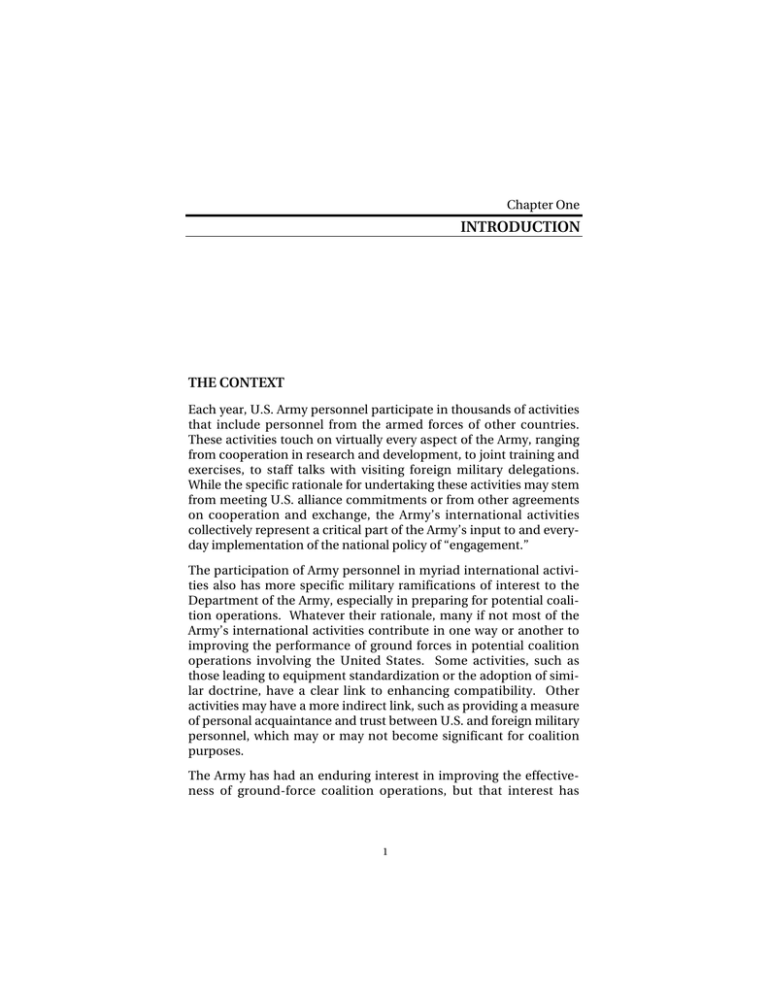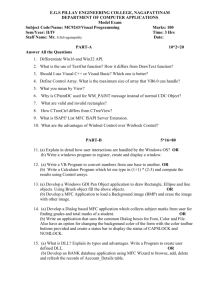INTRODUCTION THE CONTEXT
advertisement

Chapter One INTRODUCTION THE CONTEXT Each year, U.S. Army personnel participate in thousands of activities that include personnel from the armed forces of other countries. These activities touch on virtually every aspect of the Army, ranging from cooperation in research and development, to joint training and exercises, to staff talks with visiting foreign military delegations. While the specific rationale for undertaking these activities may stem from meeting U.S. alliance commitments or from other agreements on cooperation and exchange, the Army’s international activities collectively represent a critical part of the Army’s input to and everyday implementation of the national policy of “engagement.” The participation of Army personnel in myriad international activities also has more specific military ramifications of interest to the Department of the Army, especially in preparing for potential coalition operations. Whatever their rationale, many if not most of the Army’s international activities contribute in one way or another to improving the performance of ground forces in potential coalition operations involving the United States. Some activities, such as those leading to equipment standardization or the adoption of similar doctrine, have a clear link to enhancing compatibility. Other activities may have a more indirect link, such as providing a measure of personal acquaintance and trust between U.S. and foreign military personnel, which may or may not become significant for coalition purposes. The Army has had an enduring interest in improving the effectiveness of ground-force coalition operations, but that interest has 1 2 Improving Army Planning for Future Multinational Coalition Operations grown appreciably and changed in focus during the past decade. Previously, the Army’s interest in coalition operations focused primarily on achieving effectiveness with allies in high-intensity combat operations. Currently, the Army faces the challenge of having to prepare for coalition operations that span the full spectrum of military missions (peacekeeping to peace enforcement to conventional combat), in conditions of uncertainty about coalition partners (countries ranging from established allies to ad hoc partners to erstwhile adversaries), and against the background of a growing gap in military capabilities between the United States and even its closest and most affluent allies. Amidst this more difficult and uncertain environment for planning effective coalition operations, the reductions in U.S. force size in the 1990s have increased the probable role that allies and partners will play in future coalitions. Most of the major military operations that the United States has undertaken since World War II have included coalition partners and allies. The trend toward greater participation in multinational coalition operations has become even more pronounced during the past decade, especially for ground force deployments. Although the United States will retain the ability to act unilaterally, its fundamental security policy favors securing goals through multinational coalitions when possible. Thus, it appears almost certain that most future U.S. military operations will take the form of coalition operations. Regardless of whether the participation of other coalition partners ranges from little more than a political “fig leaf,” to a facilitator, to a major force contributor, the effective integration of U.S. and coalition partner forces to accomplish mission goals will be crucial to the success of future multinational operations. 1 Given such an outlook, improving the operational performance of ground force coalition operations stands among the most important tasks for the Army. Collectively, the activities designed to achieve that goal fall under the general heading of “enhancing MFC,” with MFC defined as “the ability of the United States Army and its forces ______________ 1 Future coalition operations will also entail coordination between U.S. Army units and international organizations, such as UN agencies, as well as with nongovernmental organizations. Although these linkages are important for the overall success of an operation, they are not considered here. The focus of this report is on enhancing MFC in the military-to-military domain. Introduction 3 to operate effectively as an ally or coalition partner across the full spectrum of military missions.”2 MFC enhancement activities touch on all aspects of force development. The term MFC contrasts with the concept of rationalization, standardization, and interoperability (RSI) previously used by the Army. Rather than focusing solely on materiel-technical issues, as implied by RSI, MFC also includes training, doctrine, organization, and procedures. MFC efforts have the overarching goal of achieving compatibility with partner armies in a broad set of operational categories, and, as such, they represent a holistic approach to improving the performance of multinational coalition operations. OBJECTIVES, APPROACH, AND ORGANIZATION In an overall sense, this study seeks to help the U.S. Army improve its processes for the development, guidance, and evaluation of MFC policies. It does so by helping the Army answer the following key sets of questions about the Army’s MFC policy: • When designing its coalition enhancement activities, how should the Army select among the variety of allies and partners? Which partners should be the primary targets for MFC efforts? Should some operations on the mission spectrum receive greater attention than others? • To achieve more effective coalition operations, how can the Army identify the most pressing problems in other armed forces? What programs are available to deal with these problems? What is the best way to evaluate their effectiveness? • How should the Army integrate its MFC efforts with its force development processes? In other words, how can the Army ensure that increasing the effectiveness of allied and partner armies ______________ 2 This definition is taken from Multinational Force Compatibility: Central Concepts, briefing by DUSA-IA, August 1998. The definition builds on the concepts of “multinational force” and “compatibility,” as defined in the Department of Defense Dictionary of Military Terms. Multinational Force: “A force composed of military elements of nations who have formed a temporary alliance for some specific purpose.” Compatibility: “Capability of two or more items or components of equipment or material to exist or function in the same system or environment without mutual interference.” http://www.dtic.mil/doctrine/jel/doddict/. 4 Improving Army Planning for Future Multinational Coalition Operations in coalition operations with the United States enhances the Army’s decisionmaking processes for its own force structure? To tackle these questions, we began with a comprehensive study of the existing state of affairs with regard to the Army’s formulation and implementation of MFC policy. We examined the issue of resources and funding of the Army’s international activities. We also examined the evaluation processes for MFC activities and Army objectives for MFC, based on guidance that the Army receives from the Department of Defense and the Joint Staff. We found that standard costbenefit analyses of the Army’s MFC efforts are currently difficult, if not impossible, because of data unavailability and a lack of overall Army guidelines that would allow for an evaluation of MFC efforts. Chapter Three documents our efforts. To provide the framework that would allow cost-benefit assessments of MFC efforts in the future, we then formulated an alternative approach to MFC policy. Using current scholarship on alliances and coalitions, we devised a methodology for setting priorities in the Army’s MFC policy. We also adapted a RAND-developed decision support system (DynaRank) to allow it to assess the extent and scope of other armies’ compatibility shortfalls vis-à-vis the U.S. Army. The new tool, the Military Compatibility Assessment Tool (MCAT), points to the main compatibility problems and matches the appropriate policies and programs to ameliorate the problems. In conjunction with changes in the availability and organization of data on resources spent on MFC, further modifications of DynaRank will allow for an evaluation of the effectiveness of the policies and, potentially, a consideration of allied and partner capabilities within the Army’s own force development process. Chapter Four outlines our proposed alternative approach. Three appendixes provide a database for the Army to use in MFC policy planning, documentation of the application of our methodology, and a tutorial for using the MCAT. The initial assessment of current MFC policy is based on a review of all relevant documents and regulations. We also interviewed numerous Army and Department of Defense (DoD) personnel working with MFC policy and on MFC issues. In addition, we conducted a literature search for other analytical efforts on the topic of MFC. In proposing an alternative approach to MFC policy, we borrowed heavily from relevant political science, and especially international Introduction 5 relations, theory. The MCAT stems from recent operations research work at RAND.

